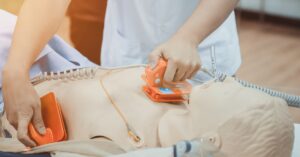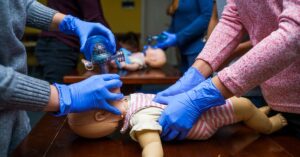CPR (Cardiopulmonary Resuscitation) is one of the best life-saving techniques to learn. It’s a critical skill to use in emergencies like heart attacks or near drownings. While a highly desired skill, plenty of discrepancies surround the truth of how valuable CPR can be in most situations. You have likely heard some misinformation on how to approach a critical emergency if you are hesitant to use CPR. Follow along as we debunk three CPR myths, separating fact from fiction so you’ll know the truth and can act when necessary.
The Reality of CPR
The reality of CPR is that, while cardiac arrest happens spontaneously, immediate use can double or even triple the chances of survival after an arrest. But how does that work—how do you do CPR? For one thing, it’s essential to know what goes on upon mouth-to-mouth contact: CPR keeps blood flow active by sending oxygen to the brain and vital organs, maintaining the patient until professional medical help arrives. The reason you should know how CPR works is not to accidentally underscore its importance in a medical emergency.
Debunking Common CPR Myths
“CPR Always Saves Lives”
What about CPR saving lives do you truly need to know? In actuality, CPR doesn’t have instantaneous success. The success rates vary due to the time it takes to start CPR and prior health conditions. About nine out of ten people outside a hospital won’t survive a cardiac arrest. CPR’s role is not about ensuring survival but improving the odds significantly.
“Mouth-to-Mouth Is Required”
The traditional way of performing CPR is outdated. Current guidelines emphasize hands-only CPR for the general public—pressing one’s hands, one stack on top of the other, fixed in the center of the chest is effective in most adult cases. You don’t push as hard on the chest in a child’s case. Simplifying CPR procedures encourages more people to act in emergencies without the hesitancy mouth-to-mouth might cause.
“You Can’t Hurt Someone by Doing CPR Wrong”
While well-intentioned, performing CPR incorrectly can be harmful. Rib fractures or internal injuries are potential risks. Proper training teaches you how to reduce risks significantly and the correct force and rhythm. Highlighting the need for adequate technique training reinforces the importance of quality CPR training.
The Impact of Misinformation
Misinformation of any kind is wrong to spread. Most importantly, it’s not right to share incorrect information on medical techniques like CPR because doing so can lead to tragic outcomes. Learning from real-life scenarios helps spin the thread of importance again, weaving the reminder of misinformation harm.
Providing Accurate Information
There is accurate information out there, and as much as you’d like to know where to look right away, you also need to do some digging. It’s essential that when you are looking for resources, you search on reputable agency websites like the American Heart Association.
Learn the Factual Reality of CPR
Let’s take another step in the direction of debunking CPR myths and separating fact from fiction by learning the factual reality. Our aim at CPR123 is to equip you with the knowledge that dispels fears and potentially saves lives. Consider expanding what you know now about CPR through classroom training for public health professionals. You not only save a life; you inform the accurate best practices.







